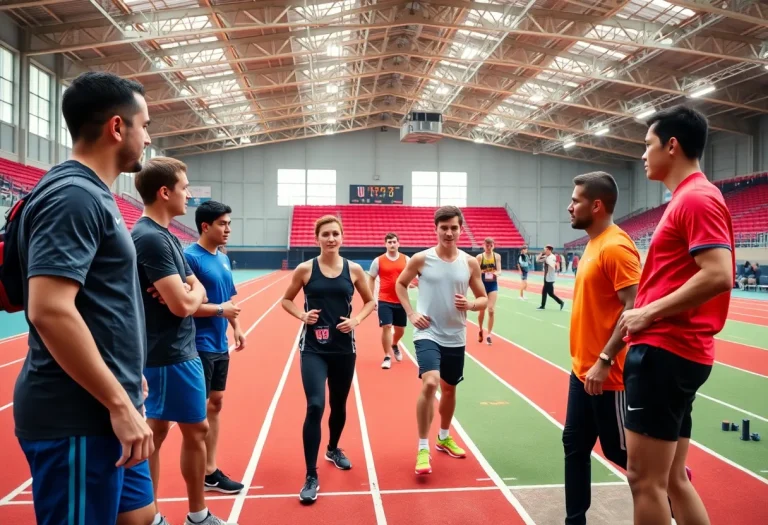News Summary
The Penn State men’s track and field team prepares for the upcoming season while facing new challenges from recent NCAA regulation changes. The limitations on team rosters and scholarship opportunities force coaches to be more selective in recruitment. With rising competition standards, aspiring athletes experience increased pressure to prove their skills. Despite these challenges, the team remains committed to maintaining a diverse lineup and building a strong competitive presence in their conference.
Penn State Track Team Faces New Challenges Amid NCAA Regulation Changes
University Park, Pennsylvania – Excitement is in the air for the Penn State men’s track and field team, especially with the Horace Ashenfelter III Indoor Track located in the Multi-Sport Indoor Facility. As they gear up for the upcoming season, they reflect on their victory in 2017, when they clinched their first outdoor Big Ten Championship. Coach John Gondak has expressed confidence in the indoor team as they are well-prepared for this year.
New NCAA Regulations Create a Stir
While the team is charged up, recent changes in NCAA regulations are shaking things up. A legal settlement known as House v. NCAA has imposed a limit on the size of team rosters, capping them at 45 athletes for both the men’s and women’s squads. This means that schools need to be a lot more selective during recruitment, which could potentially phase out traditional roles for walk-on athletes.
Scholarship opportunities have also seen a significant shift. Previously, the men’s track and field team had a cap of 12.6 scholarships, while the women’s team had 18. With the elimination of these caps, the landscape has opened up for scholarships, potentially benefiting more athletes than before. This new financial dynamic comes alongside the rise of NIL (Name, Image, Likeness) deals, which can provide additional support to collegiate athletes.
The Impact on Recruitment
With limited roster spots available, the focus on recruiting is now leaning toward landing higher-profile athletes. Coaches are finding themselves under pressure to snap up the best talent to ensure a competitive edge. This shift in approach has former walk-on athletes like Zoey Goldstein and Jake Palermo pondering the implications for new recruits.
Goldstein’s journey is a perfect example of hard work paying off; she recorded the ninth-fastest 200-meter time and the eighth-fastest 400-meter time in her senior year. Her efforts earned her a full-ride scholarship as a graduate student after shattering school records. Similarly, Palermo made headlines by breaking the indoor 400m record in just his second collegiate race.
Shifting Standards and Increased Pressure
As competitive standards for high school athletes continue to rise, coaches are becoming increasingly cautious in their recruitment strategies. The need for athletes to showcase their capabilities before securing a spot on a team has become paramount. Joe Phifer, another former walk-on, noted that tighter roster limits add to the pressure on aspiring athletes.
Adjustments Across the Board
In light of these changes, several universities, including Washington State, are adjusting their focus by reducing the number of track events and prioritizing specific disciplines. However, the Penn State track program remains determined to keep their full team intact, ensuring opportunities across all events. Coaches are undeterred in their recruitment efforts, looking for talent from varied backgrounds despite the new limitations.
While uncertainty looms over collegiate athletics due to recent adjustments and emerging lawsuits, the Penn State track team is ready to push forward. They remain committed to their goal of becoming a leading force in their conference, undaunted by the challenges that lie ahead.
Looking Ahead
As the season approaches, it’s clear that the world of collegiate sports is evolving rapidly. With changing regulations and increased competition, everywhere you look, there’s a blend of excitement and adjustment. The Penn State track team’s journey this year will undoubtedly be one to watch, as they aim to navigate these new waters while continuing to foster talent and compete effectively.
Deeper Dive: News & Info About This Topic
LIVE BALL Resources
Local Tennis Coach Wins State Award in Robesonia
Inspiring Community Stories Amid MLB Playoffs
Cambridge Hosts OVAC Cross Country Championship Amid Tragedy
Vermont High School Fall Sports Season Begins
Liv DeGori Secures Spot in PIAA Girls Golf Tournament
Soccer Stars Shine Bright at Midseason in Erie
Penn State Lands Top Women’s Lacrosse Recruit Riley Davis
Bristol Cross: A Race to Remember
Legal Battle Intensifies: Athletes Push for Criminal Charges Against NCAA Over Transgender Participation in Women’s Sports
Undefeated Women’s Volleyball Teams Make Waves in College Sports
Additional Resources
- UNF Ospreys
- Wikipedia: NCAA Division I Track and Field Championships
- Dartmouth Sports
- Google Search: NCAA regulation changes 2025
- Go Shockers
- Google Scholar: Collegiate Athlete Scholarship Changes 2025
- 12th Man
- Encyclopedia Britannica: Big Ten Championships
- Dartmouth Sports
- Google News: Name, Image, Likeness deals college athletics


